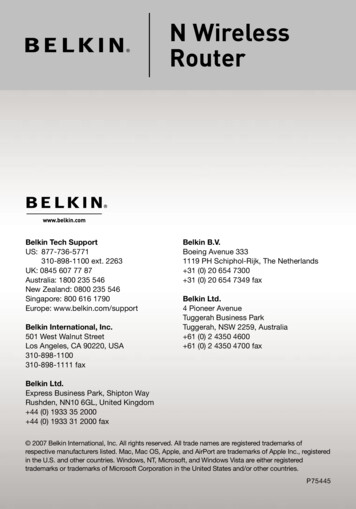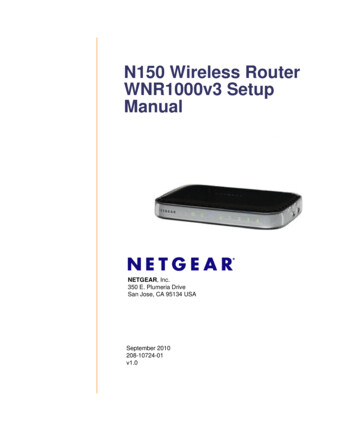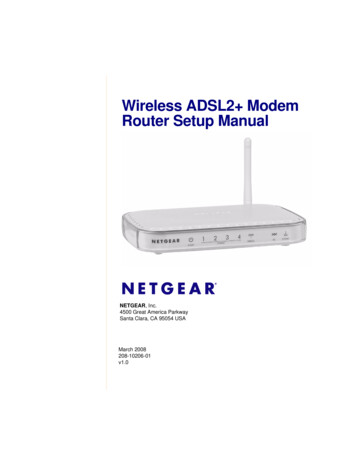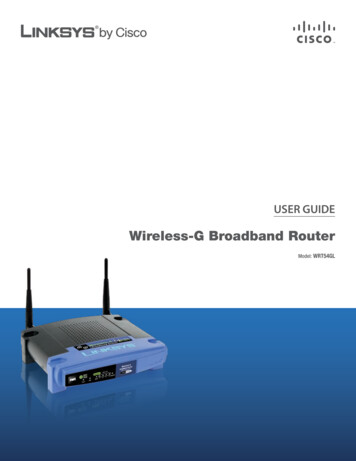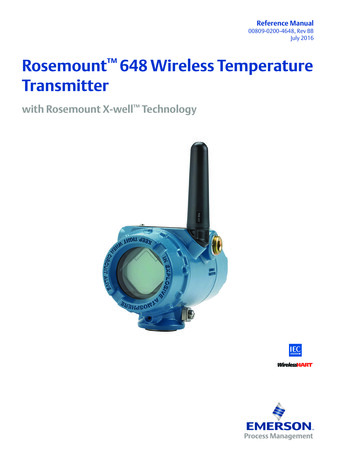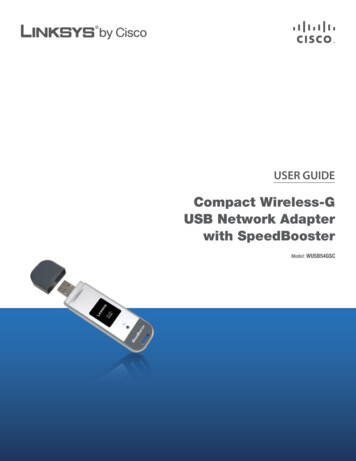
Transcription
SURVEY REPORTWireless Security Survey 2015Wireless Security Deployed: State of the Market
Wireless Security Survey 2015Wireless Security Deployed: State of the MarketWELL-FOUNDED FEARSTechnology and market trends are forcing rapid changes to enterprise IT—especially in regard to how networks are secured.92% of CIOs are worriedthat their wireless securityis inadequate. This wirelesssecurity survey shows thattheir concerns are wellfounded. Basic measuressuch as firewall andauthentication were lackingin hundreds of businessessurveyed.Growth in Unsecure Connected DevicesAs the number and types of network-connected wireless devices continue to growexponentially, these connected devices present new vulnerabilities and a growing attacksurface for hackers to exploit.Application Proliferation Enlarges Attack SurfaceGrowth of mobile applications goes hand-in-hand with the increasing number ofdevices. Enterprises not only face additional support challenges, but also new threatexposures from additional applications being introduced to the network.Operational Complexity for ITOn top of this unprecedented growth, users expect a unified access experience thatensures consistent, secure policies across wired and wireless environments. Thiscreates major challenges for IT organizations that are stressed to fill gaps in security ifpolicies are inconsistently applied and not easy to manage.This global survey studies the state of the market for wireless LAN security deployedamong 1,490 medium-to-large enterprises across a broad range of industries, andshows that the majority of enterprises have holes in their WLAN security strategy.www.fortinet.comYet, paradoxically enterprisesare embracing BYOD inrecord numbers and showinggreat interest in Cloud Wi-Fi.These are two factors thatadd complexity to any securityframework.2
SURVEY REPORT: WIRELESS SECURITY SURVEY 2015Respondent ProfilesVulnerableThe findings of this report come from an independent survey of1,490 IT decision makers (ITDMs) representing organizationswith 250 or more employees. Over 46% of organizationssurveyed exceeded 1,000 employees.According to the survey, wireless networks are ranked as themost vulnerable IT infrastructure, with the highest proportion ofITDMs (49%) placing it in their top two. Respondents positionedwireless as significantly more vulnerable than core networkinginfrastructure, with just 29% of ITDMs ranking this in the top two.FIG 1: SIZE OF ORGANIZATION BY # OF EMPLOYEESRespondent organizations came from a broad spectrum ofindustries, including the public sector. Within each sector, therewas a fairly even distribution of organization size among the foursize categories.FIG 3: VULNERABILITY OF WIRELESS VERSUS OTHER IT INFRASTRUCTUREWhile endpoint security was also noted as the secondtop concern (45%), application (17%) and storage (11%)infrastructure components were considered least at risk.Inadequate Wi-Fi Security82% of ITDMs and 92% of CIOs polled reported fears that theirWLAN security was inadequate, with nearly half of ITDMs (48%)citing the potential loss of sensitive corporate and/or customerdata as their biggest concern, and 22% citing industrialespionage as their biggest fear of operating a wireless networkwith incomplete security.Only 70% of organizations surveyed protected the WLAN witha firewall and only 63% had authentication to secure internalwireless LAN access. While more than 60% of organizationsused antivirus scanning, fewer than 40% were protectingtheir wireless networks with IPS, Application Control and URLFiltering.FIG 2: DEMOGRAPHICS OF ORGANIZATION INDUSTRIESThe relatively low deployment of IPS, application control, andURL Filtering might also suggest that wireless security is notbeing treated as solemnly as it deserves to be.All respondents were sourced from independent marketresearch company Lightspeed GMI’s online panel1 and werecustomers of all the major WLAN equipment vendors.www.fortinet.com3
SURVEY REPORT: WIRELESS SECURITY SURVEY 2015The recognized best practice for guest access is to authenticateguests through a captive portal with a unique ID and password,and to subject traffic to real-time antivirus scanning, usagecontrols (time of day, length of session, rate limits), and contentfiltering through guest policies associated with a guest SSID.All vendors offer captive portals and most also support sociallogin. Basic bandwidth management can be enforced by onsite or cloud controllers, but sophisticated application controlsrequire deep packet inspection on a specialized appliance.Antivirus and URL filtering also require additional securityappliances on the corporate LAN or in the data center.Future Security PrioritiesFIG 4: WLAN SECURITY IMPLEMENTED BY SIZE OF ORGANIZATIONIn the face of advanced persistent attacks increasingly targetedat multiple entry points, overlooking the most basic measure offirewall (29%) and authentication (37%) is playing with fire.When considering the future direction of their wireless securitystrategies, the majority of respondents said they would maintainfocus on the most common security features, namely, firewalland authentication.Unsecured Guest AccessBasic security for guest Wi-Fi was shown to be lacking as well.13% of organizations that deployed guest access on the sameWLAN infrastructure used by employees reported that guestWi-Fi is totally open, and a further 24% allow guests to use ashared username and password.FIG 6: RELATIVE PRIORITY OF FUTURE SECURITY ENHANCEMENTSAlbeit at a lower priority, demand persists for complementarysecurity technologies such as IPS, antivirus, and applicationcontrol for complete threat protection. For example, nearly 16%of respondents placed IPS as their top priority, in comparisonto under 3% flagging URL filtering as their top priority. Intrusionprevention was identified as a higher priority by respondents inhealthcare, retail, and manufacturing which have a wide varietyFIG 5: GUEST ACCESS SECURITY LEVEL IMPLEMENTEDwww.fortinet.com4
SURVEY REPORT: WIRELESS SECURITY SURVEY 2015FIG 7: % RESPONDENTS RANKING MEASURE AS THEIR TOP PRIORITYof mission-critical embedded systems such as medical devices,mobile Point of Sale (mPOS) terminals, and RFID readers. Suchembedded devices are often vulnerable to attacks that targetweaknesses in unpatched firmware.BYOD Ahead of SecurityBYOD is pervasive and unstoppable. November 2014 researchby Tech Pro Research2 indicates that 60% of organizations (upfrom 44% in February 2013) now support BYOD, and a further14% plan to allow it in the next 12 months. The findings ofthis survey suggest, however, that deployment of the securitymeasures needed to minimize the risk of BYOD has not keptpace with the rapid rate of BYOD adoption.With laptop sales giving way to tablets, enterprises can onlyexpect more employee-owned devices entering the workplaceand being used for corporate business. Enterprises need toadjust their security posture for BYOD in order to fully protectcompany data.This survey similarly found more than 76% of organizationsallow employee BYOD—and just over two-thirds of thoseemployees are permitted to access sensitive corporate data onthose user-owned devices.FIG 8: ADOPTION OF BYOD AND ACCESS LEVEL PERMITTEDUnless there are good measures in place for securing accessto sensitive data from untrusted devices, this should be agrave concern for CIOs. There are two main security issuesconcerning BYOD: securing the device itself and securing thedata streams.The market for Mobile Device Management (MDM) tools thatcheck integrity and wipe data from lost devices is languishingat 30% penetration according to Gartner estimates.3 Part ofthe reason for this is that they are limited to only securing thedevice.The other half of the equation—securing the data streams—requires corporate security policies that govern user privilegesand enforce antivirus scanning, application priorities, andcontent inspection. This is not a job for MDM. These measuresare network-based.Rogue AP detection is an increasingly relevant consideration.Almost any mobile device these days can share its radio asa virtual AP and become an attack vector. Continuous roguescreening is advisable.Cloud-managed Wi-FiRespondents were bullish about migration to cloud-managedWLANs. IDC predicts the cloud Wi-Fi market will see 46%CAGR thru 2018 and will total 2.5B in value by 2018.4www.fortinet.com5
SURVEY REPORT: WIRELESS SECURITY SURVEY 201572% of respondents said they managed at least part of theirnetwork through the cloud. Distributed enterprises such asretail and financial services led the pack with 80% penetrationof cloud-managed Wi-Fi, while large enterprises with 2,000 employees have been slower to embrace WLAN managementfrom the cloud. Only 65% of large enterprises reported usingthe cloud for some or all of their WLAN management.Many enterprises use cloud management only partially—toinitialize remote APs when installed in branch offices by non-ITpersonnel. After initial setup, ongoing management is then doneover the WAN from the corporate network or datacenter.Only 12% of respondents did not trust the cloud for WLANmanagement; however, of the 88% that do, nearly two-thirdsindicated they would prefer cloud management hosted in theirown data center rather than third-party hosted management.The Cloud Wi-Fi ParadoxFIG 9: INTEREST IN CLOUD-MANAGED WI-FIWLAN vendors are promoting their cloud Wi-Fi offerings with much gusto these days. That’s because they want to convertcustomers to subscribers. For some businesses, the CAPEX/OPEX tradeoff makes sense; for others not.What makes sense to everyone is the simplification of WLAN management that comes with the cloud. Initial setup, configuration,and maintenance are all easier—as is the implementation of basic authentication policies.But when it comes to adapting more sophisticated security measures (such as IPS, antivirus, DLP and application control), thecloud may not be best place to incorporate some of these capabilities. And implementing them to work alongside a cloud Wi-Fiarchitecture adds considerable networking complexity.Fortinet Secure Access ArchitectureWith these trends and challenges, the deployment and management of enterprise networks, applications and devices must besimplified. A network access layer that is not only secure, but also easy to manage.Fortinet’s network access solutions offer the best of next-generation firewall capabilities together with enterprise access. As opposedto traditional wireless solutions (which only address connectivity) Fortinet’s secure access solutions feature robust network security attheir core—in addition to connectivity. Fortinet secure access solutions are designed to provide the same award winning and thirdparty validated security in every type of deployment—from a stand-alone AP in an isolated office, to a handful of APs in a retail store,to thousands of APs deployed across a large enterprise campus. Our product offerings enable any business to choose the topologyand network management that best suits their needs, without having to compromise on security protection.Securing business communications, personal information, financial transactions, and mobile devices involves much more thannetwork access control. It requires scanning for malware, preventing access to malicious websites, end-point integrity checking, andcontrolling application usage. But typical Wi-Fi solutions do not cater to these requirements. Fortinet’s unique approach addressesthe shortcomings of other Wi-Fi offerings.www.fortinet.com6
SURVEY REPORT: WIRELESS SECURITY SURVEY 2015With Infrastructure, Integrated, and Cloud solutions—Fortinet offers a comprehensive set of deployment options. These threesolution options are designed to extend or upgrade existing network systems. Our secure access portfolio provides the most flexiblecyber security platform with end-to-end enforcement for enterprises of all sizes and verticals of any type.1The Fortinet Wireless Security Survey was a research exercise undertaken throughout May 2015, by market research company Lightspeed GMI. The surveywas conducted online amongst 1,490 qualified IT decision makers–predominantly CIOs, CTOs, IT Directors and Heads of IT–at organizations with morethan 250 employees around the globe. Twelve countries participated in the survey: Australia, Canada, China, France, Germany, India, Italy, Japan, HongKong, Spain, UK, and rtner.htm4Cloud-Managed WiFi Set to Grow to 2.5 Billion by 2018 (IDC #247738)GLOBAL HEADQUARTERSFortinet Inc.899 Kifer RoadSunnyvale, CA 94086United StatesTel: 1.408.235.7700www.fortinet.com/salesEMEA SALES OFFICE120 rue Albert Caquot06560, Sophia Antipolis,FranceTel: 33.4.8987.0510APAC SALES OFFICE300 Beach Road 20-01The ConcourseSingapore 199555Tel: 65.6513.3730LATIN AMERICA SALES OFFICEPaseo de la Reforma 412 piso 16Col. JuarezC.P. 06600México D.F.Tel: 011-52-(55) 5524-8428Copyright 2015 Fortinet, Inc. All rights reserved. Fortinet , FortiGate , FortiCare and FortiGuard , and certain other marks are registered trademarks of Fortinet, Inc., and other Fortinet names herein may also be registered and/or common lawtrademarks of Fortinet. All other product or company names may be trademarks of their respective owners. Performance and other metrics contained herein were attained in internal lab tests under ideal conditions, and actual performance and otherresults may vary. Network variables, different network environments and other conditions may affect performance results. Nothing herein represents any binding commitment by Fortinet, and Fortinet disclaims all warranties, whether express or implied,except to the extent Fortinet enters a binding written contract, signed by Fortinet’s General Counsel, with a purchaser that expressly warrants that the identified product will perform according to certain expressly-identified performance metrics and, insuch event, only the specific performance metrics expressly identified in such binding written contract shall be binding on Fortinet. For absolute clarity, any such warranty will be limited to performance in the same ideal conditions as in Fortinet’s internallab tests. Fortinet disclaims in full any covenants, representations, and guarantees pursuant hereto, whether express or implied. Fortinet reserves the right to change, modify, transfer, or otherwise revise this publication without notice, and the mostcurrent version of the publication shall be applicable.Oct 15, 2015
The market for Mobile Device Management (MDM) tools that check integrity and wipe data from lost devices is languishing at 30% penetration according to Gartner estimates.3 Part of the reason for this is that they are limited to only securing the device. The other half of the equation—securing the data streams—
